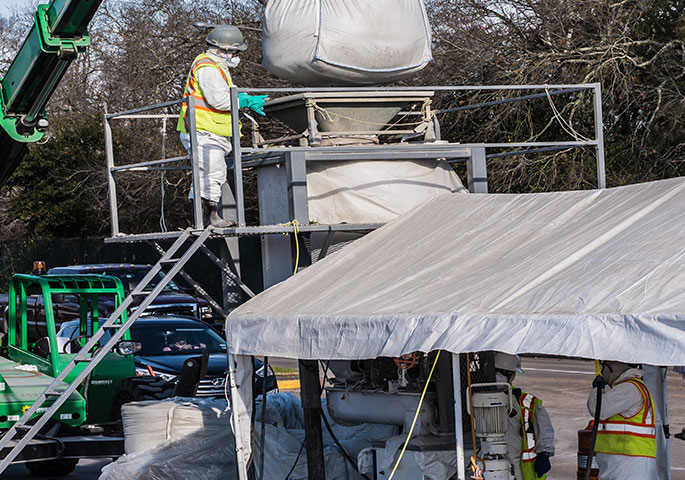
CIPP installation is one of the most popular ways to rehabilitate failing sewer pipes.
The University of Texas at Arlington Research Team Found Existing Literature on Chemical Emissions of Styrenated CIPP Non-conclusive
A four-month study on the review of published literature pertaining to chemical emissions of styrene-based resin used in the cured-in-place pipe (CIPP) process found that existing studies do not adequately capture worker exposures or levels in the surrounding areas to which workers or citizens may be exposed. The study started last December and completed on April 6, 2018 by researchers at the University of Texas at Arlington (UTA)’s Center for Underground Infrastructure Research and Education (CUIRE), and the Institute for Underground Infrastructure (IKT) in Germany. The team determined that spatial variation of concentrations, and variations in concentrations with different meteorological conditions, are not well determined.
Most of the steam-cure studies captured temporal variation in emissions, by measuring concentrations before, during and after curing. The studies were less complete in capturing spatial variation in concentrations. Most studies measured styrene around the termination manhole, or inside the manhole or sewer pipe itself. Maximum values at the outlet point and inside the terminal manhole ranged from 20 to 1,070 ppm, which are levels that exceed some exposure limits. However, since workers and certainly the public should not typically enter or stand directly at the termination manhole in the exhaust plume, this information is not very helpful.
At the steam-cured sites, additional field measurements of styrene concentrations surrounding the terminal manhole are needed. Only four of the steam-cure studies measured concentrations at locations surrounding the terminal manhole (at least 3 ft. (1 m) away), not in the manhole itself or in the exhaust plume. On one project, employees walked the construction area periodically but spent most of the time in their work trucks due to the cold weather. Hence, these measurements were likely not typical of worker exposures. Additional worker exposure data should be collected to capture variability in source emission rate, meteorological conditions, and the worker’s location with respect to the terminal manhole.
Atmospheric concentrations of compounds are functions of the source emission rate, meteorological conditions, and the receptor location. Since concentrations are expected to vary as a function of distance from the manhole, measuring at few locations gives an incomplete picture. In addition, concentrations are expected to vary with wind speed and wind direction, so measuring on one day does not capture what levels may be under differing meteorological conditions.
These earlier studies also do not adequately capture variations in emission rates from different kinds of pipes (different diameters, lengths, etc.). The overall results of the project at UTA/CUIRE/IKT indicated that the 21 papers reviewed have questionable methodologies, and therefore, the results presented are not conclusive. The researchers recommended additional sampling and data evaluation and analysis as a second phase of this study, as proposed in their final report.
NASSCO is funding additional research into chemical emissions from CIPP. NASSCO plans to have the report completed by December 2018.
Project Team
Dr. Mo Najafi supervised this project. Dr. Najafi serves as Director of the Center for Underground Infrastructure Research and Education at the University of Texas at Arlington (UTA). He is founder and Editor-in-Chief of the ASCE Journal of Pipeline Systems, and is author of four books on trenchless technology all published by McGraw-Hill: Pipeline Renewal and Asset Management; Trenchless Technology Planning, Equipment, and Methods; Trenchless Technology Piping: Installation and Inspection; and Trenchless Technology: Pipeline and Utility Design, Construction and Renewal.
Dr. Melanie Sattler provided quality control conducting the literature review and prepared a plan for sampling and analysis of emissions. Dr. Sattler serves as the Syed Qasim Endowed Professor of Environmental Engineering at UTA with a specialization in air quality.
Dr. Kevin Schug developed a plan for emissions analysis for Phase 2. Dr. Schug serves as the Shimadzu Distinguished Professor of Analytical Chemistry and as Founder and Director of the Collaborative Laboratories for Environmental Analysis and Remediation (CLEAR) at UTA. His research group solves problems using state-of-the-art sample preparation, gas chromatography, liquid chromatography, spectroscopy, and mass spectrometry techniques.
Institute for Underground Infrastructure (IKT) in Germany accessed German and European publications to augment the literature review for Phase 1. The Institute for Underground Infrastructure is a neutral, independent non-profit institute in Gelsenkirchen, Germany. The institute conducts research projects, material testing, CIPP liner testing, consultations and seminars on the construction, operation and renovation of underground infrastructures. Particular team members include Mr. Bert Bosseler, Mr. Thomas Brueggemann and Mr. Dieter Homann. Mr. Bosseler is the Scientific Director of IKT and Honorary Professor at the Institute for Geotechnical Engineering (IGTH), Hanover University, and a lecturer for sewer and pipeline engineering at the universities in Bochum, Weimar and Munich.
Graduate Research Assistants, Vinayak Kaushal, Gomathy Iyer, Satish Kakkera, Seyed Korky, Anushree Nayak, Sahar Habibzadeh, and Reza Farazifard, at the Center of Underground Infrastructure Research and Education (CUIRE) assisted in conducting the literature review.